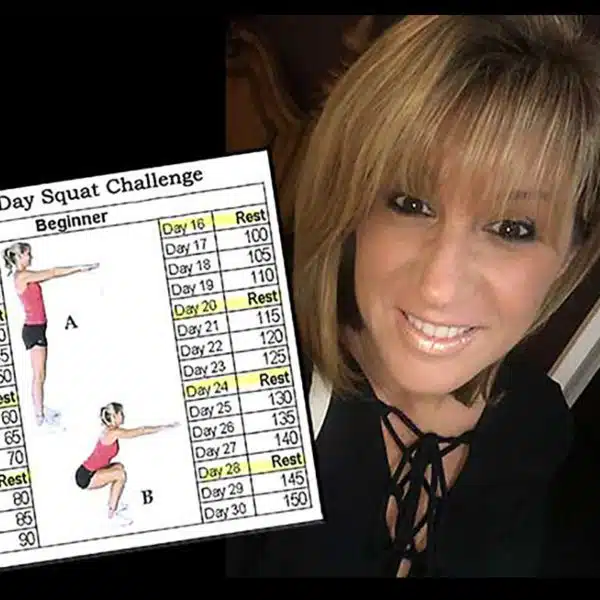Being a dental professional can have a huge impact on your body. Musculoskeletal disorders have become epidemic among dentists, assistants and hygienists. To combat these physical problems, Pi Dental Center’s staff is exercising more regularly, practicing proper ergonomic postures and taking the Squat Challenge! Daryl, an Expanded Function Dental Assistant, organized the project. Fifteen staff members are participating in this exercise challenge.
Exercising to feel comfortable and energize you throughout the day
Dentistry is physically demanding. Many dentists suffer with chronic lower back, neck, hand and wrist pain. This can make working difficult and affect quality of life. There is a direct relationship between decreased fitness levels and musculoskeletal disorders. One of the main causes of these musculoskeletal problems is prolonged static dental posture; seated while leaning forward, neck turned and twisted to the side and arm stretched out. Typically, dental professionals lean forward at the waist with the head extended forward. This position increases the risk of injury when it is maintained for long periods of time and can eventually lead to the muscles “shutting off,” thereby relaxing the stabilizing muscle structures of the spine.(1) In this posture, the loads on the lumbar spine are 40% above normal forces. During forward flexion and rotation, the pressure can increase to 400 %.(2)
It is important to recognize any discomfort while working. Common signs of a problem are pain in the hips and legs and also down the arm into the hands. These symptoms are red alerts that should not be ignored.
Repetitive tasks can shorten muscles—making them tight and painful. Stretching may increase range of motion in the joints and lengthen muscle and their associated tendons.(3) Adjust your dental seat and frequently shift position. Get up and move around whenever possible.
An article in Silver Sneakers Magazine mentions that the squat is the single most important exercise we can do when exercising. This is because life demands that we do it many times daily. We stand up, sit down, and get out of a car repeatedly every day. This is why it is important to establish a good foundation for this movement pattern. Click here for beginner squat guidelines.(4)
Repetitive motions can also contribute to muscular problems. Colgate Corporation recommends 5 easy stretches to reduce shoulder pain. Click Here to learn about exercise for dental hygienists and dentists.
Stretching throughout the day is recommended. This Article Outline Several Stretches.
Many dental professionals practice Yoga to stay in shape. Click here to view a Yoga training video designed by a dental hygienist.
Daryl is an enthusiastic advocate for healthy exercise. Before introducing the Squat Challenge to the Pi staff, she designed a worksheet with tips and goals. Next she posted a sign-up sheet, discussed the Challenge with everyone, and had a physical therapist give a demonstration. Every day, Daryl sends text messages to the staff with encouraging reminders. Since not all of the staff are at the same fitness level, the challenge is adjusted and customized to each individual. We are now on day 14 with 85 squats a day. When this challenge is complete, she plans to begin a different challenge.
Andrea, an EFDA and OSHA coordinator at Pi Dental Center, stays fit by doing yoga to stretch and relieve muscle tension. She recommends practicing proper ergonomics as outlined in OSHA’s guidelines. Ergonomics, fitting a job to a person, helps lessen muscle fatigue, increases productivity and reduces the number and severity of work related musculoskeletal disorders.
Here are some of OSHA’s recommendations. Consult the OSHA manual for a complete explanation.
- Dental assistants should sit higher than the doctor
- Keep feet flat on the floor or on a foot rest.
- Arms should rest on the chair arms
- Keep your back straight with arms and legs at a 90 degree angle.
- Align the patient in a comfortable position to avoid strain.
- Use a mirror to reduce awkward twisting of the head when possible.
Care should be taken when lifting heavy objects:
- Lift with your legs and not your back, keeping the object close to your body.
- Do not twist while lifting.
- Always bend at the knees and not the waist.
Consult your doctor before beginning a new exercise regimen. Take any exercise program at your own pace. If you feel discomfort from the exercise regimen, stop exercising and consult your doctor. When exercising, maintain proper form and perform all exercises in a slow, controlled manner.
- Musculoskeletal Disorders And The Impacts On The Dental Professional , Mahmoud Zaerian, CSCS (Oral Health Group) https://www.oralhealthgroup.com/features/musculoskeletal-disorders-and-the-impacts-on-the-dental-professional/
- Evangelos C Alexopouls, Ioanna-Chrisina Stathi, and Fotini Charizani, prevalence of musculoskeletal disorders in dentists. BMC Musculoskeletal Disorder,. 2004; 5:16.
- Merz B. Workout for aching hands. Harvard Women’s Health Watch. 2010.
Additional Links:
- Exercises You Can Do With Therapy Putty To Avoid Carpal Tunnel Syndrome.
- Why dental hygienists require special exercises.
Visit us on Facebook.

Well our jaws also need some exercise not known to many.
Post is so interesting and I really loved to read it. Thanks for sharing your thoughts. I am also a Dental Specialist.
Hi there to all, for the reason that I am genuinely keen of reading this website’s post to be updated on a regular basis. It carries pleasant stuff.
Greetings! I found this blog post to be incredibly informative and well-written. Your ability to break down complex topics into easy-to-understand language is truly a gift. Thank you for sharing your knowledge with us. I’m excited to read more of your posts in the future!